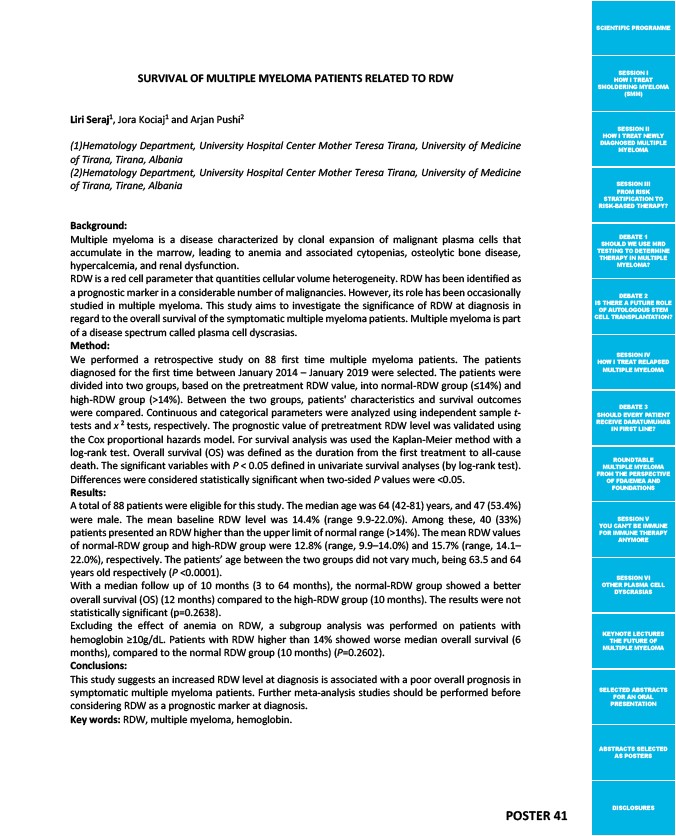
SCIENTIFIC PROGRAMME
SESSION I
HOW I TREAT
SMOLDERING MYELOMA
(SMM)
SESSION II
HOW I TREAT NEWLY
DIAGNOSED MULTIPLE
MYELOMA
SESSION III
FROM RISK
STRATIFICATION TO
RISK-BASED THERAPY?
DEBATE 1
SHOULD WE USE MRD
TESTING TO DETERMINE
THERAPY IN MULTIPLE
MYELOMA?
DEBATE 2
IS THERE A FUTURE ROLE
OF AUTOLOGOUS STEM
CELL TRANSPLANTATION?
SESSION IV
HOW I TREAT RELAPSED
MULTIPLE MYELOMA
DEBATE 3
SHOULD EVERY PATIENT
RECEIVE DARATUMUMAB
IN FIRST LINE?
ROUNDTABLE
MULTIPLE MYELOMA
FROM THE PERSPECTIVE
OF FDA/EMEA AND
FOUNDATIONS
SESSION V
YOU CAN’T BE IMMUNE
FOR IMMUNE THERAPY
ANYMORE
SESSION VI
OTHER PLASMA CELL
DYSCRASIAS
KEYNOTE LECTURES
THE FUTURE OF
MULTIPLE MYELOMA
SELECTED ABSTRACTS
FOR AN ORAL
PRESENTATION
ABSTRACTS SELECTED
AS POSTERS
DISCLOSURES POSTER 41
SURVIVAL OF MULTIPLE MYELOMA PATIENTS RELATED TO RDW
Liri Seraj1, Jora Kociaj1 and Arjan Pushi2
(1)Hematology Department, University Hospital Center Mother Teresa Tirana, University of Medicine
of Tirana, Tirana, Albania
(2)Hematology Department, University Hospital Center Mother Teresa Tirana, University of Medicine
of Tirana, Tirane, Albania
Background:
Multiple myeloma is a disease characterized by clonal expansion of malignant plasma cells that
accumulate in the marrow, leading to anemia and associated cytopenias, osteolytic bone disease,
hypercalcemia, and renal dysfunction.
RDW is a red cell parameter that quantities cellular volume heterogeneity. RDW has been identified as
a prognostic marker in a considerable number of malignancies. However, its role has been occasionally
studied in multiple myeloma. This study aims to investigate the significance of RDW at diagnosis in
regard to the overall survival of the symptomatic multiple myeloma patients. Multiple myeloma is part
of a disease spectrum called plasma cell dyscrasias.
Method:
We performed a retrospective study on 88 first time multiple myeloma patients. The patients
diagnosed for the first time between January 2014 – January 2019 were selected. The patients were
divided into two groups, based on the pretreatment RDW value, into normal-RDW group (≤14%) and
high-RDW group (>14%). Between the two groups, patients' characteristics and survival outcomes
were compared. Continuous and categorical parameters were analyzed using independent sample t-tests
and x 2 tests, respectively. The prognostic value of pretreatment RDW level was validated using
the Cox proportional hazards model. For survival analysis was used the Kaplan-Meier method with a
log-rank test. Overall survival (OS) was defined as the duration from the first treatment to all-cause
death. The significant variables with P < 0.05 defined in univariate survival analyses (by log-rank test).
Differences were considered statistically significant when two-sided P values were <0.05.
Results:
A total of 88 patients were eligible for this study. The median age was 64 (42-81) years, and 47 (53.4%)
were male. The mean baseline RDW level was 14.4% (range 9.9-22.0%). Among these, 40 (33%)
patients presented an RDW higher than the upper limit of normal range (>14%). The mean RDW values
of normal-RDW group and high-RDW group were 12.8% (range, 9.9–14.0%) and 15.7% (range, 14.1–
22.0%), respectively. The patients’ age between the two groups did not vary much, being 63.5 and 64
years old respectively (P <0.0001).
With a median follow up of 10 months (3 to 64 months), the normal-RDW group showed a better
overall survival (OS) (12 months) compared to the high-RDW group (10 months). The results were not
statistically significant (p=0.2638).
Excluding the effect of anemia on RDW, a subgroup analysis was performed on patients with
hemoglobin ≥10g/dL. Patients with RDW higher than 14% showed worse median overall survival (6
months), compared to the normal RDW group (10 months) (P=0.2602).
Conclusions:
This study suggests an increased RDW level at diagnosis is associated with a poor overall prognosis in
symptomatic multiple myeloma patients. Further meta-analysis studies should be performed before
considering RDW as a prognostic marker at diagnosis.
Key words: RDW, multiple myeloma, hemoglobin.